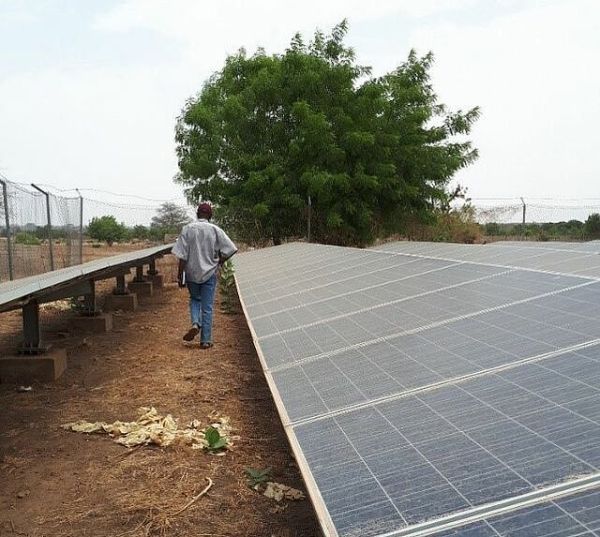NSP The Gambia – Investing in Grid-Connected Solar PV: Start of Implementation and Launch of Tender for Independent Power Producers

The Gambia has set ambitious climate goals defined in its Nationally Determined Contribution (NDC) to the Paris Agreement, aiming to have a total of 60 MW of installed solar capacity by 2025. This NAMA Support Project (NSP) Investing in Grid-Connected Solar PV in The Gambia provides incentives for the private sector to invest in solar capacity. The implementation of the project will result in 10.5 MW of installed solar capacity – 6.0 MW of installed capacity at Farafenni and 4.5 MW installed at Basse – servicing both of the country’s grids, supplying clean to satisfy approximately 144,500 people’s energy needs and reduce 322,019 tonnes of CO2 across the 26-year lifetime of the solar PV technology.
The design of this Nationally Appropriate Mitigation Action (NAMA) in The Gambia was founded upon fundamental analysis conducted over the last decade, with specific reference to the Rural Electrification with Renewable Energy in The Gambia NAMA produced by the United Nations Development Programme (UNDP) in 2015, and the Feasibility study for Grid-Connected Solar Power Generation in The Gambia developed by UNDP in 2016. The NAMA is fully embedded within The Gambia’s Vision 2020 and furthermore, it will contribute directly to the country’s NDC and its recovery from the COVID-19 crisis by providing stable solar energy throughout the day for businesses in Farafenni and Basse.
Despite rising energy demand and reducing costs of solar PV technology, a number of barriers prevent IPPs adding capacity to the regional grids, including: a lack of security around the payments made by the off-taker (NAWEC) and a lack of experience with larger scale renewable energy installations in isolated regional grids or lack of interest of independent power producers (IPP) due to challenging environment.
To address current investment barriers of IPPs in renewable energy, the NSP offers a financial de-risking package through a financing mechanism designed by the United Nations Capital Development Fund (UNCDF). The project’s financial risk will be mitigated through a power purchasing agreement (PPA) guarantee (to be issued by UNCDF using the grant provided by the NAMA Facility), whereby the IPP will be paid from funds provided by the NAMA Facility (via the guarantee) in case of a payment default on NAWEC’s side. UNDP ensured the institutional framework was sufficient to enable the project to go ahead and attract the private sector investment from the IPPs, specifically through supporting the government develop the PPA documentation, a Grid Connection Agreement and a Land Sub Lease Agreement.
The NSP implementation is now underway and is already working to achieve its key target outcomes:
- Consumers of the two grids will gain improvements in quality of life from the sustainable energy supply to their households.
- Businesses in Farafenni and Basse will be able to enhance their operations with increased, stable supply of energy during daytime.
- NAWEC will benefit from capacity building during NSP implementation.
- Through replacing electricity generated by fossil fuel-based power plants, the NSP will lead to a reduction in GHG emissions of 13,481 tonnes per year.
- The NSP aims to undertake additional feasibility studies for similar solar power plants with a capacity of 10-20 MW each – the idea being that the projects deemed financially viable through the feasibility studies could then be supported through the same financing mechanism (a PPA guarantee) that UNCDF will be overseeing during the installation of the first two solar PV sites. In that event, the NSP could result in at least two more solar PV installations beyond the project, leveraging the NSPs lasting financial mechanism.
The setting up of the partnership, the capacity building, the feasibility studies, have taken considerable time and many unforeseen challenges have had to be overcome. As a result, the national stakeholders are excited that the project is now under implementation. IPPs will be selected through a tender process which will commence in the first quarter of 2021. The capacity building of the IPPs and the NAWEC staff is well underway and the construction of the infrastructure at both sites will commence later this year.
On 24 February, UNDP launched the tender for the Indepentend Power Producer (IPP) to work and service for the construction and operation of the Solar PV plants. Offers can be submitted until 21 April 2021 through the online tendering system of UNDP here.
For more information, please see the Investing in Grid-Connected Solar PV in The Gambia case study produced by the UNDP-UNCDF team.
Learn more about The Gambia Grid Connected Solar project.
Learn more about rural electrification with renewable energy in The Gambia.
Find the online tendering system of UNDP.
